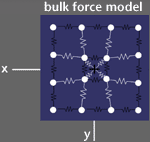
| wendy plesniak | ||||||||
 |
 |
|||||||
| Poke has two basic subsystems: the haptics |  |
|||||||
| module and the holovideo module. The former | ||||||||
| haptically displays a pliable surface and allows | ||||||||
| the underlying model to be arbitrarily reshaped | ||||||||
| by poking with the Phantom stylus. The | ||||||||
| holovideo module propagates haptic model | ||||||||
| changes into the hologram incrementally, | ||||||||
| and only in regions corresponding to change. | ||||||||
| Updated holograms are sent via HIPPI to | ||||||||
| the holovideo module's display server | ||||||||
| (running on the Cheops Imaging System) | ||||||||
| which updates the holovideo display to | ||||||||
| show the changes due to poking. | ||||||||
| There is a 2s lag between feeling changes | ||||||||
| in the haptic model and seeing them on the | ||||||||
| holovideo display. And though Poke's model | ||||||||
| can be deformed in a more arbitrary fashion | ||||||||
| than Lathe's, its hologram update rate is | ||||||||
| reduced to 0.3fps. | ||||||||
 |
Poke's force model is given by a 2D Catmull-Rom | |||||||
| spline whose control points are connected by a | ||||||||
| grid of springs. As a person presses into the | ||||||||
| surface with the Phantom stylus, the grid and | ||||||||
| the surface near the contact point are recruited | ||||||||
| in the resulting deformation as shown below. | ||||||||
| In this deformation, control points are restricted | ||||||||
| to move only in depth (z). | ||||||||
| The holographic image shows an array of points | ||||||||
 |
||||||||
| collocated with the haptic model control points, | ||||||||
| and the surface is felt to stretch among them. | ||||||||
| The holographic image is updated rapidly | ||||||||
| using the incremental computing method which | ||||||||
| assembles the image from a set of precomputed | ||||||||
| elemental fringes. This method lets us make fast | ||||||||
| and flexible local changes in the hologram. | ||||||||
 |
||||||||
|
A
table of elemental fringes is first
|
||||||||
| computed by interfering a plane wave | ||||||||
| with a set of spherical waves. These | ||||||||
| spherical waves arise from a set of | ||||||||
| points located at a finely-sampled set | ||||||||
| of distances from the hologram plane. | ||||||||
| Each fringe in the table reconstructs | ||||||||
| an image of a point at the same depth | ||||||||
| used to originally produce the fringe. | ||||||||
|
A
fringe can be translated in the hologram
|
||||||||
|
to
translate its reconstructed image, and
|
||||||||
 |
||||||||
|
a
fringe can be reversed to flip the depth
|
||||||||
|
of
its image. Arbitrary images can be
|
||||||||
|
constructed by adding appropriately
|
||||||||
|
arranged fringes from the table into
|
||||||||
|
a composite pattern, as shown at the
|
||||||||
|
right for a simple 2-point image.
|
||||||||
|
Since
the hologram of any scene
|
||||||||
 |
||||||||
|
modeled
by a collection of image points
|
||||||||
|
is
simply a linear superposition of all
|
||||||||
|
points'
elemental fringes, we can erase
|
||||||||
|
any
point from the image by subtracting
|
||||||||
|
its
fringe from the pattem as shown.
|
||||||||
|
The
image of that point can be updated
|
||||||||
|
by
adding a new fringe to reconstruct
|
||||||||
|
the
point at a new location. Poke uses
|
||||||||
|
this approach to update its hologram as
|
||||||||
 |
||||||||
|
a person deforms the pliable surface.
|
||||||||
|
This
method requires operating on a
|
||||||||
|
144MB
"working" hologram, which is
|
||||||||
|
subsequently
normalized and sent to
|
||||||||
|
the
display server on Cheops.
|
||||||||
| Sponsors of this work include Honda R&D Company, | ||||||||
| NEC, IBM, the Digital Life Consortium at the MIT | ||||||||
| Media Laboratory, the Office of Naval Research | ||||||||
| (Grant N0014-96-11200), Interval Research Corporation, | ||||||||
| and Mitsubishi Electric Research Laboratories. | ||||||||